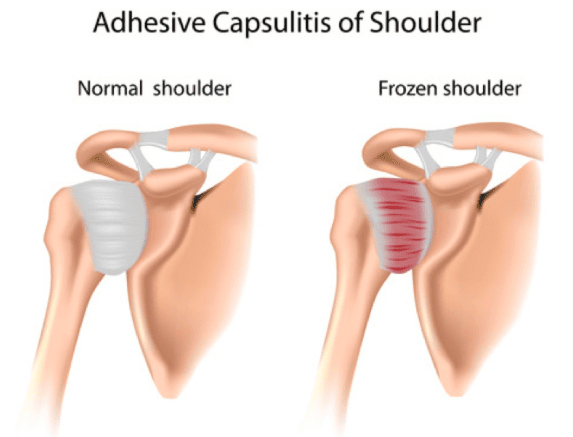Frozen shoulder is one of the most common areas of concern we see here at Burquitlam Physiotherapy.
Frozen shoulder is also known as adhesive capsulitis, where the shoulder joint becomes very stiff and inflamed, making it difficult to move. Range of motion of the shoulder joint is reduced, especially in movements like reaching overhead or behind oneself. It is most common in individuals over the age of 50 and often affects women more than men. Frozen shoulder is also more likely to occur in individuals with a sedentary lifestyle, as the shoulder will stiffen up over time due to inactivity.

Generally, there are two types of Frozen Shoulder:
Primary Frozen Shoulder:
People who develop frozen shoulder with no underlying cause.
Secondary Frozen Shoulder:
People who develop frozen shoulder from underlying causes such as:
- Previous shoulder injury (within the last year or so)
- Previous shoulder surgery
- Other shoulder conditions
- Treatment for breast cancer, including radiotherapy or axillary lymph node dissection
- Other medical conditions such as diabetes mellitus and thyroid disease greatly increase the likelihood of developing frozen shoulder
The most common way to treat frozen shoulder in a clinic setting is to get the shoulder joint moving as much as possible, with the aim of restoring shoulder mobility. Exercises that utilize active range of motion are very effective, where we use cables or dumbbells to assist the shoulder joint in increasing range of motion in a certain direction.
The main directions we address in the shoulder joint are shoulder flexion, scaption, abduction, internal rotation, and external rotation. We often use cable pulleys for frozen shoulder injuries. The general idea when addressing frozen shoulder is to begin with a lot of assistance from the pulley, gradually reducing the weight as the patient regains range of motion. More weight from the pulley translates to more assistance, as the pulley is doing more of the work in actively moving the shoulder joint in a certain direction.
Typically patients will have a greater range of motion through active range of motion than passive range of motion. Passive motion is when the patient moves their shoulder joint on their own with no external assistance. As the patient regains some of their mobility, we will reduce the weight of the pulley so that the patient’s shoulder joint is doing more of the work in the new range of motion.
One thing to note is as we are increasing the patient’s shoulder range of motion further and further, we want to be cognizant of any pain they are experiencing. Mild pain is sometimes common when trying to increase range of motion, but we don’t want moderate or severe pain during any of the exercises. If a patient experiences moderate or severe pain, we will reduce the range of motion for their exercises until they are able to complete those exercises pain-free.
If you suspect you suffer from frozen shoulder, you don’t have to allow it to continue to restrict your life. Call us at 604-282-1284 or email burquitlamphysiotherapy@gmail.com to book a consult today and start your path towards recovery!
Sam Lee
Registered Kinesiologist


Recent Comments